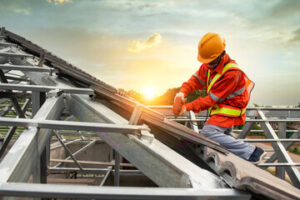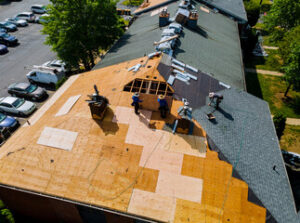The roof is one of the most important parts of a home, but it also goes through extensive wear and tear over time. Replacing an aging or damaged roof is an investment that can pay off in both the structural integrity of your house and the value of your property.

The cost of a roof replacement depends on several factors, including the type and size of roofing materials, the complexity of the design and labor costs. The price tag for a new roof can range from $6,700 to $80,000 or $11,500 on average for an average-sized home. The cost of materials accounts for up to 40% of the total cost. The size of your roof also affects the amount of time and materials needed to complete the project, with larger roofs requiring more work to replace than smaller ones. Visit https://www.fresnoroofcompany.com/ for more details.
The shape of your roof and any special features, such as skylights or chimneys, also increase the cost of the project. In addition, the pitch of your roof (how steep it is) affects how easy or difficult the job will be. Steeper pitches require more materials, painstaking labor and potentially specialized equipment to install, and can result in higher costs.
Another important factor is the location of your home, which influences both material and labor costs. For example, Florida and the Pacific Northwest are more expensive than other parts of the country because they require roofing materials that can withstand heat, humidity and storms.
Finally, the cost of financing will impact your overall cost. If you have enough equity in your home, a mortgage can be the most cost-effective way to finance a roof replacement. However, some homeowners choose to take out a personal loan instead of putting their home on the line, which may come with higher interest rates and requires less upfront capital.
It’s worth mentioning that while repairs are usually less expensive than replacing the entire roof, a patched up roof can lower your property value when it comes time to sell and can be costly in the long run if damage is extensive or spreads. However, if your roof is nearing its end of life or you notice leaks in more than one area, a full roof replacement is probably a good idea.
If you’re unsure about whether a repair or a replacement is the best option for your home, contact a local roofing company for a quote. They will assess your roof and provide a recommendation based on their experience in your area.
Materials
There are many factors that can affect the overall cost of reroofing a home, including geographic location, roof size and material type. The choice of roofing materials is probably the most significant factor and one that homeowners can control. There are many options available, and each has its own set of benefits. Some may provide greater value, add curb appeal or offer energy efficiency. It is important for homeowners to know as much about these materials as possible so they can make an informed decision and select the best option for their needs.
There is a wide variety of shingles on the market, from basic three tab shingles to luxury copper. Asphalt shingles are typically the least expensive and provide good protection. Metal shingles are also a popular choice and can help save money on heating bills. However, they require more maintenance and can be noisy and expensive to install.
Wood shakes or shingles are a more traditional roofing material that provides a natural aesthetic to the home and last up to 60 years. They are easy to maintain and can be repaired fairly easily. However, they are prone to rot and insect damage. They must be regularly painted to prevent rust.
Tile roofs are very durable and can last up to 50 years. They are prone to breakage and brittleness, and need regular cleaning and re-tiling. They are most suitable for warmer climates.
A flat roof can be constructed of a variety of materials, but EPDM and TPO membranes are the most common. They are made from layers of felts or ply sheets that have been saturated with bitumen or polymer. The seams are then glued or hot-air welded together.
There are many other things that can increase the overall cost of a new roof, such as the pitch, roof features like chimneys and skylights, and the size of the roof. If a homeowner is considering replacing their roof, they should discuss the costs and benefits of each option with a contractor. Also, homeowners should take the time to examine their existing roof to see if it can be repaired instead of replaced.
Installation
A roof combines a lot of elements that sit on top of your home and need to be installed in the right order to function properly. Your local roofing contractor will assess the condition of your current roof and recommend the best course of action for replacement. They’ll also help you select the type of roofing materials that will best suit your climate and budget. They’ll also make sure you get all the other components you need, such as ice and water barriers, flashing, vents, and underlayment.
Once you’ve chosen your materials, your roofing contractors will begin by clearing your roof. They’ll move outdoor furniture and other items that might get damaged to a safe place. They’ll also clear debris and remove gutters that might be in the way of removing old shingles. Next, they’ll start tearing off your old roof. They’ll start at the far end of your house and work their way toward your driveway, where a dumpster and new roofing materials will be stationed temporarily. During this step, they’ll also remove old flashing and underlayment.
When the shingles are removed, your contractors will inspect the underlying structure for damage and repair it as needed. They’ll replace rotten or warped boards, and they may need to add insulation as well. Depending on the type of roof, they might need to replace or re-seal areas around penetrations like vents and chimneys.
Once the underlying structure is ready, your roofing contractors will install underlayment. This is a sheet of waterproof material that goes over the sheathing and acts as an initial barrier to moisture. It’s normally tucked under the shingles and fastened with nails or staples.
If you live in a region with severe weather, your contractors will likely install ice and water barriers as well. These protective membranes prevent melting ice from backing up under the shingles and damaging the sheathing underneath.
Your roofing contractors will also replace or install vents for attic ventilation. Proper attic ventilation helps your roof last longer by allowing hot air to escape and cold air to flow in. They’ll also replace or install pipe boots, which protect the plumbing pipes that stick out of your roof.
Maintenance
As your roof is the first line of defense against the elements, it needs to be regularly checked and maintained. This can include re-caulking seams, re-sealing minor cracks, and replacing damaged materials.
A maintenance program should be designed to maximize the life of a new roof and avoid costly repairs in the future. It typically includes a comprehensive inspection and cleaning to remove dirt and debris from the roof surface, as well as checking the condition of drains, gutters, and flashing. The inspection should also check for any signs of leaks, mold, or rot.
During the initial inspection, a checklist should be created and any problems identified should be recorded in writing. This will help to prevent small issues from becoming major problems in the future. Ideally, roof inspections should be conducted at least twice per year, with a biannual schedule being ideal in certain geographic regions that experience varying weather types.
In addition to inspecting the actual roofing structure, it is also important to check the fascia, which is located at the bottom edge of the roof. This is often neglected and can be subject to a number of issues, including wood rot, animal damage, and mold growth. This can lead to water intrusion into the home and may cause interior walls and electrical units to become corroded.
A good maintenance plan should also take into account the conditions of the chimney and any large accessories like skylights and vent outlets. Keeping these clean and in good working order can significantly extend the lifespan of a roof. In the case of a tile roof, it is important to inspect the tiles for brittleness, mold, and other potential damage. The plan should also address any previous repairs and ensure they are still in good working order.
Other items to consider include ensuring that all access points for rooftop work are in good repair, such as stairs, crossovers and platforms. This is especially important if there is electrical, harmful chemicals or hot equipment on the rooftop. It is also a good idea to limit the number of people allowed on the roof so that accidental damage can be minimized.
